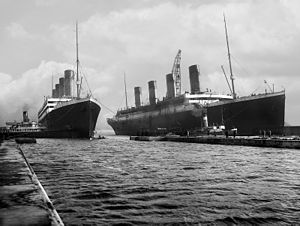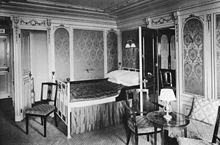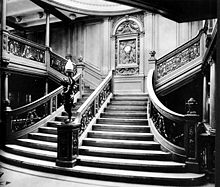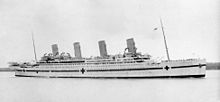- Olympic class ocean liner
-

Belfast, Ireland, 6 March 1912: Titanic (right) had to be moved out of the drydock to allow her sister Olympic, which had lost a propeller blade, to have it replaced.Class overview Builders: Harland and Wolff, Belfast, Ireland[1] Operators:  White Star Line[1]
White Star Line[1]Built: 1908–1914 In service: 1911–1935 Planned: 3 Completed: 3 Lost: 2 Retired: 1 Preserved: 0 General characteristics Type: Ocean liner[1] Tonnage: app. 46,000 gross - Titanic's figures displayed as all three vessels differ in dimensions, tonnage & horsepower.[1] Displacement: app. 52,500 tons Length: 882 ft 9 in (269.06 m)[1] Beam: 92 ft 6 in (28.19 m)[1] Height: app. 60 ft (18 m) above water line Draught: 34 ft 7 in (10.54 m)[1] Installed power: - 24 double-ended (six furnace) and 5 single-ended (three furnace) Scotch boilers[1]
- Two four-cylinder triple-expansion[1] reciprocating engines each producing 15,000 hp for the two outboard wing propellers at 75 revolutions per minute
- One low-pressure turbine[1] producing 16,000 hp to the centre propeller
- 59,000 hp was produced at maximum revolutions
Propulsion: Speed: 21 kn (38.9 km/h; 24.2 mph)[1] Capacity: 3,295 passengers,officers,and crew[1] Notes: Approximate cost 7.5 million (USD) (approx. $177.56m at 2008 prices) The Olympic-class ocean liners were a trio of ocean liners built by the Harland & Wolff shipyard for the White Star Line in the early 20th century. Although the three were the largest and most luxurious of their time, two were lost early in their careers: Titanic sank on 15 April 1912 after hitting an iceberg in the North Atlantic, and HMHS Britannic sank on 21 November 1916, after hitting a mine laid by the German minelayer, U-79, triggering one of the mines laid in a barrier off of Kea during World War I. Olympic, the eldest sister and namesake of the class, continued in service until she was laid up and scrapped in 1935, alongside Cunard's RMS Mauretania.[2]
Although two of the three vessels did not have successful careers, they are among the most famous ocean liners ever built. Decorative elements of Olympic were purchased to adorn many places (and even a cruise ship, Celebrity Millennium). Titanic's story has been adapted into many films and books, and Britannic has also inspired a movie of the same name.[3]
Contents
Origin and construction
The Olympic-class had its origins in the intense competition between the United Kingdom and Germany in the construction of the liners. The Norddeutscher Lloyd and HAPAG, the two largest German companies, were indeed involved in the race for speed and size in the late nineteenth century. The first in service for the Norddeutscher Lloyd was SS Kaiser Wilhelm der Grosse, which won the Blue Riband in 1897 [4] before being beaten by SS Deutschland of HAPAG in 1900.[5] Then followed the three sister ships of the Kaiser Wilhelm der Grosse: SS Kronprinz Wilhelm, SS Kaiser Wilhelm II and SS Kronprinzessin Cecilie all of whom were part of a "Kaiser class". In response to this, the Cunard Line of the UK ordered two vessels whose speed earned them the nickname "greyhounds of the seas:" Lusitania and Mauretania.[6] Mauretania kept the Blue Riband for more than twenty years, from 1907 to 1929.[7][2]
The White Star Line knew that their Big Four, a quartet of ships built for size and luxury but not speed,[8] were no match for the Cunard's new liners. In 1907, J. Bruce Ismay, president of White Star and William J. Pirrie, director of the shipyard Harland & Wolff decided to build three vessels. And so, the Olympic-class ships were built to surpass rival Cunard's largest ships, Lusitania and Mauretania, in size and luxury. Titanic, along with her sisters, Olympic and the soon to be built Britannic (provisionally named Gigantic),[9] were intended to be the largest and most luxurious ships to operate on the North Atlantic, but not the fastest, as the White Star Line had already switched from high speed to size and luxury. The three vessels were designed by Thomas Andrews and Alexander Carlisle.[2]
Construction of Olympic started in December 1908 and Titanic in March 1909. The two ships were built side by side.[10] The construction of Gigantic began in 1911 after the commissioning of Olympic and Titanic's launch. Following the sinking of Titanic, Gigantic was renamed Britannic, and the two remaining vessels underwent many changes in their safety provisions.[11]
Specification
Propulsion was achieved through three propellers: two lateral propellers had three blades, while the central propeller had four. The two lateral propellers were powered by reciprocating steam triple expansion, while the central shaft was driven by a steam turbine.[12] All power on board was drived from a total of 29 coal-fired steam boilers in six compartments. However, Olympic's boilers were adapted for firing by oil at the end of the First World War,[13] which reduced significantly the number of engine crew required to operate the ship from 350 to 60.[14]
The vessels were 269 metres (883 ft) long, their tonnage surrounded 46,000 GRT.[15] Olympic, originally the smallest of the three, became the biggest British ship ever constructed after her refit in 1912, until the commissioning of RMS Queen Mary in 1936.[16] All three vessels transported four funnels, with the fourth being a dummy which was used for ventilation purposes. On the one hand it was a decoration to establish a symmetry in the ships' profile, on the other hand it prevented the large amount of ventilation cowls on deck as on Cunard's Lusitania and Mauretania.[15]
Sixty-four lifeboats were the number possible to be added to each ships.[17] However, only 20 boats were installed on Olympic and Titanic to avoid cluttering the deck and provide more space for passengers. Shipbuilders of the era envisaged the ocean liner itself as the ultimate lifeboat and therefore envisaged that a lifeboat's purpose was that of a ferry between a foundering liner and a rescue ship. Despite the low number of lifeboats, both Olympic and Titanic exceeded Board of Trade regulations of the time.[18] Following the sinking of Titanic, more lifeboats were added to Olympic (some lifeboats might even have been from the foundered Titanic[17]). Britannic, meanwhile, was equipped with eight special large davits to be able to launch many lifeboats at the same time.
Features
The three vessels had similar but a little different level of passenger accommodation. However, no class was neglected. The first class passengers enjoyed luxurious cabins, some were equipped with bathrooms. The two most luxurious even included a private promenade deck.[Note 1] There were also large dining rooms, a lavish Grand Staircase built only for the Olympic-class ships,[19] a Georgian-style smoking room, a Cafe Veranda decorated with palm trees,[20] and even a swimming pool, Turkish bath,[21] gymnasium,[22] and several other places for meals and entertainment.
The second class also had good accommodations. A smoking room, a library, a spacious dining room, and an elevator was available for the second class. It was also expected to propose a gym on board Britannic.[23]
Finally, the third-class passengers enjoyed reasonable accommodation compared to other ships, if not up to the second and first classes. Instead of large dormitories offered by most ships of the time, the third-class passengers of the Olympic-class lived in cabins containing two to ten bunks. The class also had a smoking room, a common area, and a dining room. Britannic provided third-class passengers more comfort than its two sister ships.[24]
Olympic
Main article: RMS OlympicOlympic was launched on October 20, 1910[25] and commissioned on June 14, 1911.[26] She made her maiden voyage on June 14, 1911. On 20 September of the same year, under Edward J Smith, she collided with the cruiser HMS Hawke in the port of Southampton, leading to her repair back at Harland and Wolff.[27] After the sinking of Titanic, Olympic underwent a number of refinements to improve her safety. She then resumed her commercial service.
During the First World War, the ship served as a troop transport. On May 12, 1918, she rammed and sank the German submarine U-103.[28] Once placed back in the commercial service during 1920, she crossed the Atlantic with two ships seized from Germany, Majestic and Homeric.[16] In 1934, she again sank a ship by a collision with the Nantucket Lightship LV-117, causing the death of the four occupants, and three more died later.[29]
Following the merger of White Star Line and Cunard Line in 1934, Olympic was taken out of service in 1935, and scrapped between 1935 & 1937.
Titanic
Main articles: RMS Titanic and Timeline of the sinking of the RMS TitanicTitanic was launched on May 31, 1911,[30] and her commissioning was slightly delayed due to ongoing repairs of Olympic.[31] The ship left the port of Southampton April 10, 1912 for her maiden voyage, narrowly avoiding a collision with SS New York, a ship moored in the port pulled by the propellers of Titanic. After a stopover at Cherbourg, France and another in Queenstown, Ireland, she sailed into the Atlantic with 2,200 passengers on board (a total capacity of 3,500), under the command of Captain Edward J. Smith headed for New York City. The crossing took place without major incident until Sunday, April 14 at 23:40.[32]
Titanic struck an iceberg at 41°46′N 50°14′W / 41.767°N 50.233°W.[33] while sailing about 400 miles south of the Grand Banks of Newfoundland shortly before midnight. The strike and the shock blew the rivets, thus opening a leak in the hull below the waterline. This caused the first five compartments to be flooded while the ship could only stay afloat with four compartments flooded. The ship sank 2 hours and 40 minutes after the collision and with not enough lifeboats for all of the passengers,[17] 1,517 of the 2,223 people on board were killed, making it one of the deadliest peacetime maritime disasters in history.
Britannic
Main article: HMHS BritannicBritannic was launched on 26 February 1914 at the Harland and Wolff shipyard in Belfast and fitting out began.[34] In August 1914, before Britannic could commence transatlantic service between New York and Southampton, World War I began. Immediately, all shipyards with Admiralty contracts were given top priority to use available raw materials. All civil contracts (including the Britannic) were slowed down.
On 13 November 1915, Britannic was requisitioned as a hospital ship from her storage location at Belfast. Repainted white with large red crosses and a horizontal green stripe, she was renamed HMHS (His Majesty's Hospital Ship) Britannic.[34]
08:12 AM on 21 November 1916, The HMHS Britannic struck a mine[Note 2] at 37°42′05″N 24°17′02″E / 37.70139°N 24.28389°E,[35] and sank. 1,036 people were saved. Thirty men lost their lives in the disaster. One survivor, nurse Violet Jessop was notable as having also survived the sinking of the RMS Titanic in 1912, and had also been on board RMS Olympic, when it collided with the HMS Hawke in 1911. The Britannic was the largest ship lost during World War I.[36]
Legacy
Wrecks and expeditions
The sinkings of Titanic and Britannic did not receive the same attention. Because the exact position of the sinking of the Britannic is known and the location is shallow, the wreck was discovered relatively easily in 1975.[37] Titanic, however, drew everyone's attention in 1912. After several attempts, more or less serious, but equally unsuccessful, the wreck was finally located by Jean-Louis Michel of Ifremer and Robert Ballard following a secret mission for the U.S. Navy.[38] The discovery of the wreck occurred on 1 September 1985, at 25 kilometers from the position given of the sinking. The wreck lies about 4,000 meters deep, broken in two. The bow is relatively well preserved, but the stern imploded during the sinking.[Note 3]
The wreck of Britannic was discovered in 1975 by Jacques-Yves Cousteau. It has a large tear in the front caused by the bend of the bow when the ship rolled over. She has been, after the discovery, regularly seen as part of many other expeditions.[39]
Cultural heritage
Museums and exhibitions pay tribute to the ships, and the two tragedies have inspired many movies, novels, and even musicals and video games.
When decommissioned, Olympic was previously set to be converted into a floating hotel,[40] but the project was canceled. However, its decorative elements were auctioned. The First Class Lounge and part of the Aft Grand Staircase, can be found in the White Swan Hotel, in Alnwick, Northumberland, England. The à la carte restaurant of Olympic is now restored on the Celebrity Millennium.[41]
Notes
- ^ This last provision was a novelty on board Titanic.
- ^ The hypothesis of the sinking caused by a mine was the one that had been accepted by the inquiry following the sinking. However, it's possible that the sinking was caused by a torpedo [1](Accessed March 21, 2009)
- ^ On the contrary to the bow, the stern of the ship was not filled with water when it sank, and imploded as a result of the air.
References
- ^ a b c d e f g h i j k l m n Maritimequest: Titanic's Data
- ^ a b c Othfors, Daniel. "Olympic". The Great Ocean Liners. http://www.thegreatoceanliners.com/olympic.html. Retrieved 2008-09-08.
- ^ / "Britannic (2000) (TV)". Imdb.com. http://www.imdb.com/title/tt0190281 /. Retrieved 2009-05-26.
- ^ (Olivier Le Goff 1998, pp. 22–23)
- ^ (Olivier Le Goff 1998, pp. 24–25)
- ^ (Olivier Le Goff 1998, pp. 32–33)
- ^ (Olivier Le Goff 1998, p. 70)
- ^ (Mark Chirnside 2004, p. 11)
- ^ Origins Of The Olympic Class, RMS Olympic Archive. Retrieved August 8, 2009[dead link]
- ^ (Mark Chirnside 2004, p. 14)
- ^ (Gérard Piouffre 2009, p. 307)
- ^ (Mark Chirnside 2004, p. 30)
- ^ (Olivier Le Goff 1998, p. 37)
- ^ Olympic Returns To Passenger Service, RMS Olympic Archive. Retrieved August 8, 2009
- ^ a b Chirnside, Mark (2004). The Olympic-Class Ships. Tempus Publishing Ltd.. ISBN 0752428683.
- ^ a b (Mark Chirnside 2004, p. 308)
- ^ a b c (French) Les canots de sauvetage, le Site du Titanic. Retrieved July 29, 2009
- ^ Parks Stephenson. Retrieved June 12, 2011
- ^ (French) Les escaliers de 1 Classe, le Site du Titanic. Retrieved July 30, 2009
- ^ (French) La Vie à bord du Titanic, le Site du Titanic. Retrieved July 30, 2009
- ^ (French) Les Bains Turcs et la Piscine, le Site du Titanic. Retrieved July 30, 2009
- ^ (French) Le Gymnase, le Site du Titanic. Retrieved July 30, 2009
- ^ History, Hospital Ship Britannic. Retrieved July 30, 2009
- ^ Third class areas, Hospital Ship Britannic. Retrieved July 30, 2009
- ^ (Mark Chirnside 2009, p. 36)
- ^ (Mark Chirnside 2009, p. 47)
- ^ (Gérard Piouffre 2009, p. 69)
- ^ Paul Chack, Jean-Jacques Antier, Histoire maritime de la Première Guerre mondiale, France - Empire, 1992, p. 778
- ^ (French) Le RMS Olympic, L'histoire du RMS Olympic, RMS Titanic et HMHS Britannic. Retrieved August 8, 2009
- ^ (Gérard Piouffre 2009, p. 60)
- ^ (Mark Chirnside 2004, p. 135)
- ^ (French) Chronologie d'un naufrage, le Site du Titanic. Retrieved August 10, 2009
- ^ Question No. 25 - When and where did the collision occur?, RMS Titanic, Inc. Retrieved July 6, 2007
- ^ a b (Mark Chirnside 2004, p. 240)
- ^ (Mark Chirnside 2004, pp. 254–255)
- ^ "PBS Online - Lost Liners - Britannic". PBS. http://www.pbs.org/lostliners/britannic.html. Retrieved 2008-11-09.
- ^ (French)L'Olympic et le Britannic, le Site du Titanic. Retrieved August 3, 2009
- ^ Gérard Piouffre, Le Titanic ne répond plus, Larousse, 2009, p. 296
- ^ (English) The Wreck, Hospital Ship Britannic. Retrieved August 3, 2009
- ^ (English) Mark Chirnside interview, january 2005, Mark Chirnside's Reception Room. Retrieved August 4, 2009
- ^ Millennium, Celebrity Cruises. Retrieved August 4, 2009
Further reading
- Chirnside, Mark: The Olympic-class ships. Tempus, 2004 (ISBN 0-7524-2868-3)
- (French) Le Goff, Olivier: Les Plus Beaux Paquebots du Monde. Solar, 1998 (ISBN 9782035841964)
- (French) Piouffre, Gérard: Le Titanic ne répond plus. Larousse, 2009 (ISBN 2-263-02799-8)
- Titanic & Her Sisters / Tom McCluskie, Michael Sharpe, Leo Marriott (1998) ISBN 1571451757
External links
 Media related to Olympic class ocean liners at Wikimedia Commons
Media related to Olympic class ocean liners at Wikimedia CommonsOlympic-class ocean liners Categories:- Ships of the White Star Line
- Ship classes
- Olympic class ocean liners
- Ocean liners with four funnels
Wikimedia Foundation. 2010.





